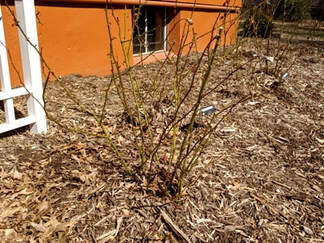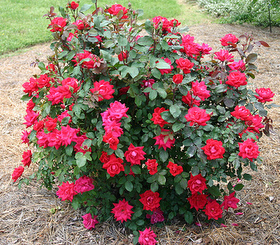Urban Transplanting Rose Bushes In Winter Inspirations
Late winter to early spring is the best time. Make the New Hole.

Rose Transplanting Tips On When And How To Transplant A Rose Bush
Pull up the rose and shake andor wash the soil from.

Transplanting rose bushes in winter. Thoroughly water the rose bush again and let the water drain. As roses are sensitive to shock moving them while dormant in late winter or early spring is generally recommended. Transplanting of Dormant Rose Bushes.
Transplant the rose bush as quickly as possible. Plant the rose shrub in its new hole with its bulbous graft two to four inches 5 to 10 cm below soil level. In our zone 7 December through the first of February is the ideal time.
The day before you transplant your rose bushes water the soil around the rose bush very well. Spread out the roots of your roses then set the root ball in your prepared hole at the new planting site. How to Transplant Rose Bushes When to Transplant.
Prune the dormant plant back by. After it drains fill the hole with the remaining soil. Transplanting rose bushes in the spring time decreases the chances of wilting shock and the plant dying.
Add more soil and tamp it every few inches. Amend the soil from the new hole with organic materials like shredded leaves composted manure or garden compost. The best time to transplant most shrubs and bushes is in the fall and early winter while they are dormant or close to it.
Backfill halfway with the amended soil and fill the hole with water. When transplanting rose bushes in spring wait until all threat of frost or freezing weather has passed. The soil should also be relatively warm and manageable.
Rose bushes are sensitive to shock so the handle moving better when they are dormant in late winter or early spring. Cover deeply with your hay straw or leaves and pile remaining compost on top to weight it down. You need to ensure all dangers of freezing weather or frost is gone before.
Carefully dig around the plant with a sharp spade or shovel. Place the soil taken from the planting. To help ease the transition a little preparation is in order.
Bare-root roses will need a cone-shaped mound of soil on which. Dig the hole for your new rose 18 to 20 inches 46-51 cm in diameter and at least 20 inches 51 cm deep sometimes 24 inches 61 cm if you are moving an older bush. Reach down and pull the rose out by the base of the plant giving it a shake to release the soil form the roots.
The longer the roots are out of the ground the higher the odds of killing the plant. The best time to transplant roses is in the spring or fall but if your plant is in a bad situation. Make sure your soil has good drainage as.
Fill in around the rose bush with half the excavated soil. Their dormancy period is usually in late winter or early spring. Lever up the roots.
Fill in the hole halfway with the mix of compost and soil youve set on the side then water it. Keep the roots well watered. Prune back the bulk of.
The Soil is soft and easy to work and the rosebush is nearly dormant. Place the rose roots into a bucket of plain water. It takes a hard freeze to trigger plants into dormancy.
Move the plant in this bucket to avoid drying out. If needed add some soil underneath to boost it. Place the rose bush carefully into its new hole.
However transplanting in the. Mulch the area around the trunk to reduce water evaporation. Dig a new hole one that is big enough to fit the entire root ball of the plant.
Once the water soaks in fill in the rest of the dirt then water again. Therefore moving or transplanting them while they are still dormant is advised. Fill the Rest of the Hole With Soil.
When your order of dormant roses arrives simply pull away the covering for each hole and plant as usual. Not a frost but a really hard freeze where the temperatures dip below 32 degrees F. In warm-winter climates this is.
Prune the above-ground growth by two-thirds. Read on to learn how to transplant your rose bush and keep it healthy and alive. If the soil is still warm the second-best period is in the fall around the end of October or early November.
Place the bush in the hole on the mound spreading out the roots. In the weeks before you make the move water the plant with B1 fertilizer to prevent shock. Carefully lift out the root ball taking as much soil with it as possible.
The rose bush should be sitting slightly above ground level. Use your hands to gently push the soil through the root ball then water thoroughly. Make sure the crown is sitting at or slightly above ground level then fill the hole halfway with soil.
Start by waiting until April or May for best results. Cut the rose canes back to about 10 to 12 inches and remove all remaining foliage. When the hole is full and level with the rest of the area build a raised edge around the drip line of the bush about 2 inches high to hold the water.
The upcoming warm weather will aid in the bushs regeneration. If you are transplanting them in the spring make sure that it is after the last frost or threat of freezing. Transplanting Season Begins after the 1st Hard Freeze in the Fall.
You can remove the rose from the ground by digging far enough away from the root ball so the roots are not damaged. For a period of at least a few hours. Secondly can I move roses in July.
It is very important to keep the roots moist until planting into the new location. Dig about 12 inches 31 cm around the bush and approximately 15 inches 38 cm deep. First you will need to select a good sunny spot for your rose bush or rose bushes paying attention to the soil at the selected site.
This will insulate the soil in the planting hole and slow the rate of freezing. Once that happens the plants go to sleep for the winter and rest. Plant the Rose Bush.
Never let the roots dry out. Dig a generous hole around the plant - at 30cm deep and 30cm from the stem. Ask This Old House landscape contractor Roger Cook shows how to transplant a rose bushSUBSCRIBE to This Old House.
Roses are very sensitive to shock. The top of the root bulb should be about an inch above ground level. The best time to transplant roses is in early spring when the plant is still dormant.
For transplanting roses the best time is during winter when the bush is dormant and before the leaf buds break. This will make it easier to dig and ensure that the plant is hydrated. Early spring is the best time of year to transplant roses for most of the United States.
Prepare Your Rose Bush.

Repotting And Transplanting Roses The Gardener The Gardener

Planting Roses Rose Bushes The Complete Guide Ashridge Nurseries

Why Is My Newly Planted Rose Bush Dying Thriving Yard

Transplanting Roses Kansas City Rose Society

Transplanting Rose Bushes Pat Welsh Organic And Southern California Gardening
A Little Trick When Moving A Mature Rose Bush Finegardening

Transplanting Climbing Roses Hgtv

Moving A Rose Bush Toronto Master Gardeners

How To Save A Dying Rose Bush Flower Patch Farmhouse

The Right Way To Transplant A Rose Stuff Co Nz

How To Transplant A Rose Bush Youtube

Rooting Roses Growing Roses From Cuttings

How To Transplant Roses Gardener S Path

Growing Roses New Mexico State University Be Bold Shape The Future

How To Transplant And Prune Roses Graphic Heavy Planting Roses Pruning Roses Transplanting Roses

Transplanting Guide When And How To Transplant Flowers Vegetables

How To Transplant Roses Gardener S Path

How To Transplant A Rose Bush Ask This Old House Youtube

Transplanting Roses Transplanting Roses Roses Garden Care Rose Garden Landscape

Post a Comment for "Urban Transplanting Rose Bushes In Winter Inspirations"